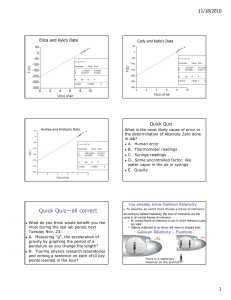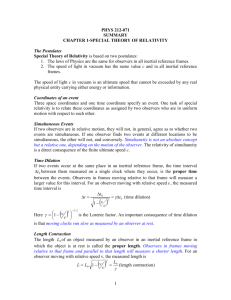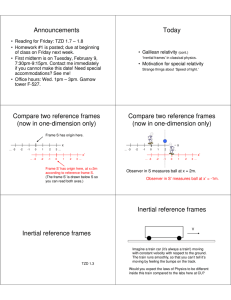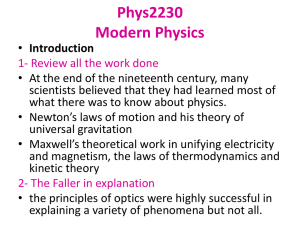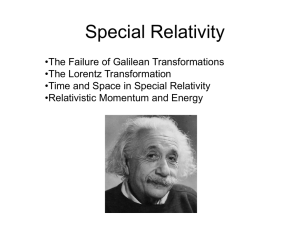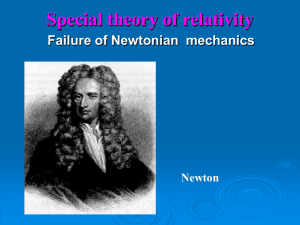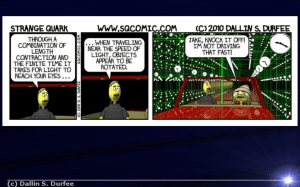CHAPTER 2: Special Theory of Relativity
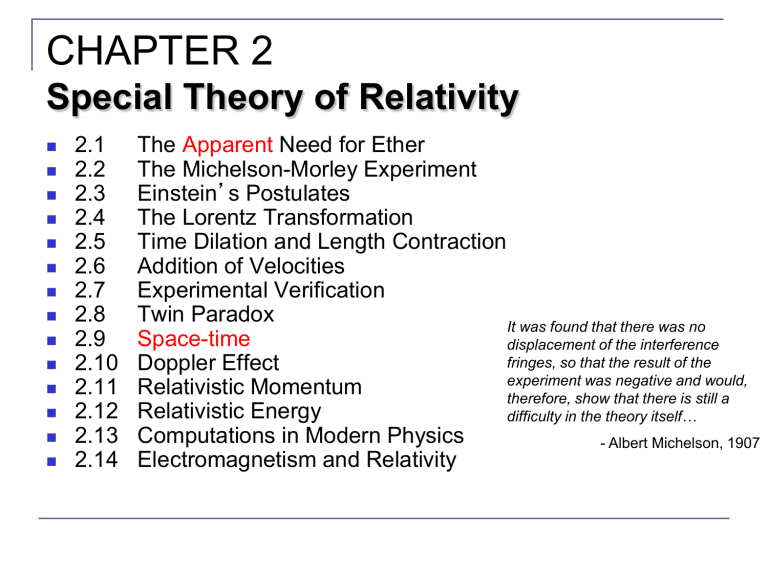
CHAPTER 2
Special Theory of Relativity
2.1
The Apparent Need for Ether
2.2
The Michelson-Morley Experiment
2.3
Einstein ’ s Postulates
2.4
The Lorentz Transformation
2.5
Time Dilation and Length Contraction
2.6
Addition of Velocities
2.7
Experimental Verification
2.8
Twin Paradox
2.9
Space-time
2.10 Doppler Effect
2.11 Relativistic Momentum
2.12 Relativistic Energy
2.13 Computations in Modern Physics
2.14 Electromagnetism and Relativity
It was found that there was no displacement of the interference fringes, so that the result of the experiment was negative and would, therefore, show that there is still a difficulty in the theory itself…
- Albert Michelson, 1907
Newtonian (Classical) Relativity
Assumption
It is assumed that Newton ’ s laws of motion must be measured with respect to (relative to) some reference frame.
Inertial Reference Frame
A reference frame is called an inertial frame if Newton laws are valid in that frame.
Such a frame is established when a body, not subjected to net external forces, is observed to move in rectilinear (along a straight line) motion at constant velocity.
Newtonian Principle of Relativity or
Galilean Invariance
If Newton ’ s laws are valid in one reference frame, then they are also valid in another reference frame moving at a uniform velocity relative to the first system.
This is referred to as the Newtonian principle of relativity or Galilean invariance.
Inertial Frames K and K ’
K is at rest and K ’ is moving with velocity
Axes are parallel
K and K ’ are said to be INERTIAL COORDINATE SYSTEMS
The Galilean Transformation
For a point P
In system K: P = ( x , y , z , t )
In system K ’ : P = ( x ’ , y ’ , z ’ , t ’ ) v t x
P
K
K ’ x ’ -axis x-axis
Conditions of the Galilean Transformation
Parallel axes
K ’ has a constant relative velocity in the x -direction with respect to K
Time ( t ) for all observers is a Fundamental invariant , i.e., the same for all inertial observers
The Inverse Relations
Step 1. Replace with
Step 2. Replace “ primed ” quantities with
“ unprimed ” and “ unprimed ” with “ primed ”
The Transition to Modern Relativity
Although Newton ’ s laws of motion had the same form under the Galilean transformation,
Maxwell ’ s equations did not.
In 1905, Albert Einstein proposed a fundamental connection between space and time and that Newton ’ s laws are only an approximation.
Historical remark: The year 1905 was annus mirabilis (Latin: the year of wonders), as Albert Einstein made important discoveries concerning the photoelectric effect, Brownian motion special theory of relativity.
2.1: The Apparent Need for Ether
The wave nature of light suggested that there existed a propagation medium called the luminiferous ether or just ether .
Ether had to have such a low density that the planets could move through it without loss of energy
It also had to have an elasticity to support the high velocity of light waves
Maxwell ’ s Equations
In Maxwell ’ s theory the speed of light, in terms of the permeability and permittivity of free space, was given by
Thus, the velocity of light must be a constant.
An Absolute Reference System
Ether was proposed as an absolute reference system in which the speed of light was this constant and from which other measurements could be made.
The Michelson-Morley experiment was an attempt to show the existence of ether.
Similarity between the Michelson-Morley interferometer and the race between two swimmers between floats anchored in the river bed.
Assumptions
Equally fast swimmers
Speed of each swimmer = c
Water velocity or drift of the ether with respect to the earth = v l
1
l
2 v
c
2
D v v
v
2 c l
1
A C t
2 l c
2 v
2 t ll
c
2
2 lc
v
2 t ll
t
1
1
v
2
/ c
2 l
2 The perpendicular swimmer wins!
t ll
t
2.2: The Michelson-Morley Experiment
Albert Michelson (1852 –1931) was the first
U.S. citizen to receive the Nobel Prize for
Physics (1907), and built an extremely precise device called an interferometer to measure the minute phase difference between two light waves traveling in mutually orthogonal directions.
The Michelson Interferometer
1. AC is parallel to the motion of the Earth inducing an “ ether wind ”
2. Light from source S is split by mirror A and travels to mirrors C and D in mutually perpendicular directions
3. After reflection the beams recombine at A slightly out of phase due to the “ ether wind ” as viewed by telescope E.
The system was set on a rotatable platform
Typical interferometer fringe pattern, which is expected to shift when the system is rotated
The Analysis
Assuming the Galilean Transformation
Time t
1 from A to C and back on parallel course:
Time t
2 from A to D and back on perpendicular course:
.
So that the change in time is:
The Analysis (continued)
Upon rotating the apparatus, the optical path lengths ℓ
1 and ℓ
2 are interchanged producing a different change in time: (note the change in denominators)
The Analysis (continued)
Thus a time difference between rotations is given by: and upon a binomial expansion, assuming v / c << 1, this reduces to
Results
Using the Earth ’ s orbital speed as:
V = 3 × 10 4 m/s together with ℓ
1
≈ ℓ
2
= 1.2 m
So that the time difference becomes
Δ t
’ − Δ t ≈ v 2 ( ℓ
1
+ ℓ
2
)/ c 3 = 8 × 10
−17 s
The light period this is about T= λ/c~600nm/(3 10 8 m/s)=2 10 -15 s, thus ( Δ t
’ − Δ t) /T~0.04 ( λ is a wavelength of light wave).
Although a very small number, it was within the experimental range of measurement for light waves.
Michelson ’ s Conclusion
Michelson noted that he should be able to detect a phase shift of light due to the time difference between path lengths but found none.
He thus concluded that the hypothesis of the stationary ether must be incorrect.
After several repeats and refinements with assistance from Edward Morley (1893-1923), again a null result.
Thus, ether does not seem to exist!
Most famous "failed" experiment, but great conclusive results!
Possible Explanations
Many explanations were proposed but the most popular was the ether drag hypothesis.
This hypothesis suggested that the Earth somehow “ dragged ” the ether along as it rotates on its axis and revolves about the sun.
This was contradicted by stellar aberration wherein telescopes had to be tilted to observe starlight due to the Earth ’ s motion. If ether was dragged along, this tilting would not exist.
The Lorentz-FitzGerald Contraction
Another hypothesis proposed independently by both
H. A. Lorentz and G. F. FitzGerald suggested that the length ℓ
1
, in the direction of the motion was contracted by a factor of thus making the path lengths equal to account for the zero phase shift, which is seen from the equation
This, however, was an ad hoc assumption that could not be experimentally tested.
2.3: Einstein ’ s Postulates
Albert Einstein (1879 –1955) was only two years old when Michelson reported his first null measurement for the existence of the ether.
At the age of 16 Einstein began thinking about the form of Maxwell ’ s equations in moving inertial systems.
In 1905, at the age of 26, he published his startling proposal about the principle of relativity , which he believed to be fundamental.
Einstein ’ s Two Postulates
With the belief that Maxwell ’ s equations must be valid in all inertial frames, Einstein proposes the following postulates:
1)
2)
The principle of relativity : The laws of physics are the same in all inertial systems.
There is no way to detect absolute motion, and no preferred inertial system exists.
The constancy of the speed of light :
Observers in all inertial systems measure the same value for the speed of light in a vacuum.
Revisiting Inertial Frames and the Reevaluation of Time
In Newtonian physics we previously assumed that t = t ’
Thus with “ synchronized ” clocks, events in K and
K
’ can be considered simultaneous
Einstein realized that each system must have its own observers with their own clocks and meter sticks
Thus, events considered simultaneous in K may not be simultaneous in K ’ .
The Problem of Simultaneity: “Gedanken”
(German) (i.e. thought) experiment
Frank at rest is equidistant from events A and B:
A B
−1 m +1 m
0
Frank “ sees ” both flashbulbs go off simultaneously.
The Problem of Simultaneity v is at the same 0 position when flashbulbs go off, but she sees event B and then event A.
v
−1 m 0 +1 m
A B
Thus, the order of events in K’ can be different!
We thus observe…
Two events that are simultaneous in one reference frame (K) are not necessarily simultaneous in another reference frame (K ’ ) moving with respect to the first frame.
This suggests that each coordinate system must have its own observers with “ clocks ” that are synchronized…
Synchronization of Clocks
Step 1: Place observers with clocks throughout a given system
Step 2: In that system bring all the clocks together at one location
Step 3: Compare the clock readings
If all of the clocks agree, then the clocks are said to be synchronized
A method to synchronize…
One way is to have one clock at the origin set to t = 0 and advance each clock by a time
( d / c ) with d being the distance of the clock from the origin.
Allow each of these clocks to begin timing when a light signal arrives from the origin.
t = 0 t = d / c d d t = d / c
The Lorentz Transformations
The special set of linear transformations that:
1)
2) preserve the constancy of the speed of light
( c ) between inertial observers; and, account for the problem of simultaneity between these observers known as the Lorentz transformation equations
Lorentz Transformation Equations
Lorentz Transformation Equations
A more symmetric form:
Properties of γ
Recall β = v / c < 1 for all observers
1)
2) equals 1 only when v = 0
Graph of β :
(note v ≠ c )
Homework (will be not graded):
Problems
2.2. #6,7
2.3. #9
2.4. #11, 12,13
